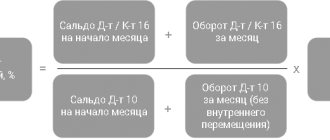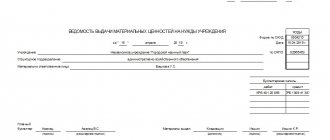Items used for work, like any equipment, become unusable. To exclude them from the organization’s property, it is necessary to carry out a write-off procedure. For government institutions, Order No. 52n of the Ministry of Finance of Russia dated March 30, 2015 applies, which regulates, among other things, the forms of documents required for disposal. The sample act for writing off materials for production depends on the type of property being written off. There are:
- act on write-off of inventories;
- act on the disposal of soft and household equipment.
The sample act for writing off inventory differs not only in the type of asset, but also in the form of the form.
Basis for compilation
The basis for compilation may be:
- an inventory was carried out, during which it became clear that some of the accounting objects needed to be disposed of;
- initiative of persons responsible for the use of values (PRO).
The reason for writing off materials in the write-off act depends on what kind of material assets are supposed to be written off. For example, the disposal of soft equipment may be due to the wear and tear of the item, stationery must be transferred according to a statement from the MOL to the direct user (statement for issuing valuables for the needs of the institution according to form 0504210), dishes are entered according to the tableware breakage registration book (form code 0504044). In case of destruction of inventory items, approved documents must be attached.
Responsible persons are members of the commission for the receipt and disposal of assets. They are appointed by order of the head of the institution.
Write-off procedure
Material assets are accounted for at the actual cost of acquisition. The total does not take into account indirect taxes paid to the supplier. Identical groups of goods may have different prices when purchasing batches of heterogeneous prices. Write-off of valuables is carried out depending on the method approved in the accounting policy:
- First in stock (FIFO). To obtain cost data, it is necessary to maintain records by supply batches.
- Accounted for at average cost. The method is characterized by a change (averaging) in the cost of balances with each new arrival of a consignment of goods.
- At cost per accounting unit.
The method established by internal documents cannot be changed when valuables are written off. To transfer to production by writing off valuables, use the requirement-invoice M-11 (or limit-fence card No. M-8, invoice No. M-15) and the act.
Useful: how to write off inventory items for production or sale
Accounting and tax accounting for the write-off of inventory items (material assets) depends on the type of these assets and the grounds for their write-off (disposal).
Inventories include inventories (MPI), as well as finished products (clause 2 of the Accounting Regulations “Accounting for inventories” PBU 5/01, approved by Order of the Ministry of Finance of Russia dated 06/09/2001 N 44n (hereinafter referred to as PBU 5/01), clause 3.15 of the Guidelines for the inventory of property and financial obligations, approved by Order of the Ministry of Finance of Russia dated June 13, 1995 N 49). Read more in ConsultantPlus
Accounting for processing of customer-supplied raw materials
Accounting for tolling resources provides an important nuance. The raw materials do not become the property of the processor; therefore, they cannot be reflected on balance sheet accounts. Reflect the MH received from the customer on off-balance sheet account 003.
Inventory continues to be listed with the customer in the main accounting account 10 “Materials”. We recommend opening a special sub-account to detail the accounting of customer-supplied resources. For example, subaccount 10-7 “Materials transferred for processing to third parties”, in accordance with instructions No. 94n.
At the dealer's
Reflect the accounting entries in the seller's accounting:
| Operation | Debit | Credit |
| MH transferred to the contractor | 10-7 | 10-1 10-8 |
| Transferred MH written off | 08, 20, 26, 44 | 10-7 |
| The cost of the contractor's work is reflected | 60 | |
| Unused MH returned | 10-1 10-8 | 10-7 |
From the contractor (processor)
In the contractor's accounting, reflect the following accounting entries:
| Operation | Debit | Credit |
| Customer-supplied raw materials received | 003 | |
| Written off by MH Davaltsa based on reporting | 003 | |
| Reflected processing costs | 20 | 10, 02, 70, 69 |
| The cost of the work was presented to the counterparty | 62 | 90, according to subaccount revenue |
| VAT charged | 90, VAT subaccount | 68 |
| Cost written off | 90, according to sub-account cost | 20 |
Sample filling
Let's give a sample act of writing off material assets that have fallen into disrepair, using the example of a children's institution canteen.
Step 1. Fill in the number and date, name of the organization, structural unit, OKPO code, INN and KPP of the institution, financially responsible person, members of the commission for the receipt and disposal of assets, details of the order on the basis of which the commission operates.
Step 2. The commission, in the presence (in our case) of the canteen manager, checks whether the valuables have really become unusable, which they certify with signatures. Decides on the need to exclude from the valuables items that do not meet the requirements for them.
Step 3. After filling in all the required fields, the last sheet is filled out with the signature of the chairman and members of the commission. They can be the administrative staff of the organization, accounting workers, and other specialists.
Issued in two copies. One of them is transferred to the appropriate service in order to reflect the data in accounting. The second remains with the financially responsible person as a document confirming the disposal of the material.
Document flow for writing off materials for construction and installation work
Let's consider the procedure for drawing up a document according to form No. M-29, approved by the Instructions.
In Section I of the report “Standard requirements for materials and volumes of work performed,” columns 2, 4, 5, 6, 8 are filled in by the construction organization’s technical department before the start of construction of the facility, and column 9 - only for transitional objects at the beginning of the year.
Column 2 “Name of types of work, structural elements and materials” is filled out as follows. First, the type of construction and installation work is recorded (excavation work, stone work, flooring, etc.), then the name of the structural element with a list of materials required for its implementation.
Column 4 “Unit of measurement” indicates the units of measurement of the structural element and the materials required for its implementation.
Column 5 “Justification of production standards for the consumption of materials” records the numbers of tables, paragraphs and the abbreviated name of the collections of production standards that this construction organization uses in its work.
In column 6 “Rates of material consumption per unit of measurement of work (structural element)”, based on the relevant collections of production standards, the rates of material consumption per unit of measurement of construction and installation work are indicated.
Column 8 “Scope of work and standard requirements for materials for the entire facility” is filled out as follows. For each type of work (structural element), the physical volume of construction and installation work is shown, provided for by the working drawings for the entire facility under construction, and for each type of materials - its standard requirement (limit) for the corresponding type of work (structural element), which is calculated by multiplying the norm material consumption (column 6) for the corresponding volume of construction and installation work (structural element) given in column 8.
If the construction of a facility has been ongoing for more than one year, then in column 9 “Including the volume of work actually completed at the beginning of the reporting year” for each unfinished type of work (structural element) from the total volume of work for the entire facility under construction (the column identifies the volume of construction and installation work , actually completed in previous years.
identifies the volume of construction and installation work , actually completed in previous years.
Columns 10 to 21 are filled in by the work contractor directly during construction of the facility. They reflect the volume of work performed for each type (structural element) for the corresponding reporting month and the standard consumption of each type of materials, calculated as the product of the standard consumption of materials (column 6) by the volume of work performed for the month.
As noted above, data on the volume of work actually performed is determined on the basis of a log of work performed, compiled according to form No. KS-6a.
After the end of the reporting month, for each type of material, the total standard consumption for all work according to production standards is determined and recorded on the corresponding total lines of Section I, which is then transferred to columns 5, 9, etc. section II.
If an overestimation of the volume of work performed is detected in Form No. M-29, the volume of work performed for the period in which the overestimation was detected must be corrected and, accordingly, the consumption of materials for the volume of work performed must be clarified. Materials previously written off for work must be reported to the financially responsible persons.
Section II of the report “Comparison of the actual consumption of basic materials with the consumption determined by production standards” indicates the amount of materials consumed for each reporting month according to production standards, and the actual savings or overconsumption of materials and the amount of materials allowed to be written off to the cost of construction and installation work .
If the construction of the facility has been ongoing for more than one year, then in Section II the data from the “Total since the beginning of construction” columns of Section II of the report for the previous year is transferred to the “Total at the beginning of the year” columns.
If the object is being built for the first year, then dashes are added in the report in the “Total at the beginning of the year” columns.
The consumption of materials for the reporting month, calculated according to production standards (for filling out columns 5, 9, 13, etc.), is taken from the final data of Section I of the report on the relevant materials.
The actual consumption of each type of materials for the month is shown in section II of the report in form No. M-29 for the entire facility based on primary expenditure documents.
The amount of materials consumed, indicated in the report on Form No. M-29, must correspond to the amount of materials given in the material report.
Savings or overconsumption of materials for each month are determined as the difference between actual consumption and consumption calculated according to production standards, and is recorded in columns 7, 11, etc. In this case, savings are shown with a minus sign (–), and overspending is shown with a plus sign (+).
For each case of excessive consumption of materials, the foreman provides a written explanation in the prescribed form (Appendix No. 3 to the Instructions), which is attached to the report.
The report in form No. M-29 is confirmed by the signature of the site manager (foreman), after which it is submitted to the technical department and accounting department of the construction organization for verification.
The technical department checks in the report the correctness of the foreman’s determination of the consumption of basic materials according to the standards for the volume of work performed and the foreman’s explanation of the reasons for the overconsumption of materials, if the overconsumption occurred in the reporting period, and the accounting department checks the correctness of the data on the actual consumption of materials. The results of the inspection are certified by the signatures of the persons performing the inspection.
After checking the report and the foreman’s explanatory note about the reasons for the cost overrun, the construction organization’s manager approves the report and indicates (in columns 8, 12, etc.) the amount of materials to be written off as construction and installation costs.
In cases where the amount of basic materials actually spent on construction and installation works is less than the amount calculated according to the standards, the amount of actually consumed materials is approved for writing off as the cost of construction and installation work.
If the amount of basic materials actually spent on the production of construction and installation work is greater than the amount calculated according to the standards, and the overconsumption of materials is technically justified or caused by production necessity (for example, overconsumption of metal when forced to replace reinforcement with large diameters due to the lack of reinforcement of the required dimensions), then the cost of construction and installation work, the amount of materials allowed for write-off by the head of the construction organization is written off.
Technically unjustified excess consumption of materials (for example, due to violations of labor or production discipline) is not written off as the cost of construction and installation works.
If the amount of basic materials actually spent on construction and installation work exceeds the amount allowed for write-off, then the head of the construction organization, on the foreman’s explanatory note about the reasons for the overexpenditure, indicates to which accounting accounts the cost of these materials should be attributed: to account 76 (sub-account “Calculations for claims”). or to account 94 “Shortages and losses from damage to material assets”, if no decision has been made to recover from the perpetrators.
Based on the manager’s decision, indicated on the foreman’s explanatory note, the accounting department makes appropriate corrections to the data on the actual consumption of materials in the material report.









